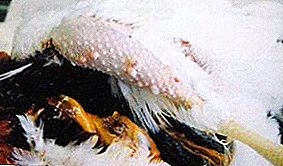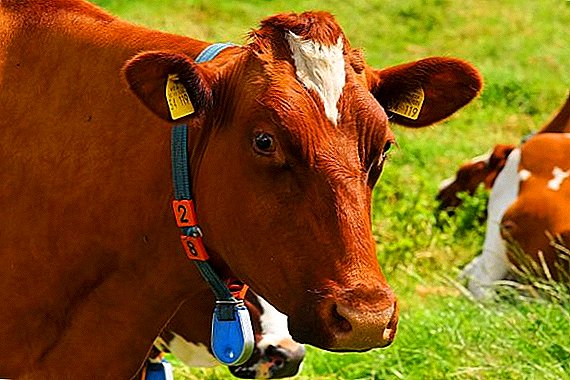
Chickens are kept and raised both at home and in farms, the popularity of this kind of activity is due to the fact that it is very profitable and profitable, it allows you to get fresh and high-quality meat, eggs for personal use and wholesale deliveries to markets, shops .
Being engaged in poultry farming, farmers face the fact that birds become infected with various diseases, the most dangerous are infectious diseases, which pose a threat not only to birds susceptible to the disease, but also to humans. Therefore, it is necessary to know the main symptoms, risk groups, vectors, measures of prevention and treatment of such a dangerous infectious disease as chicken bronchitis.
What is infectious bronchitis chickens?
Infectious bronchitis (IB, Infectious bronchitis, Bronchitis infectiosa avium) is a highly contagious viral disease that affects the respiratory organs in young individuals, reproductive organs in adult birds, and reduces the productivity of adult hens and egg production.
History reference
 Infectious bronchitis, a respiratory disease, was first classified and described Schalk and Haun in 1930 in the USA (North Dakota), but they have not established the cause of the disease of the birds by the virus and the causative agent.
Infectious bronchitis, a respiratory disease, was first classified and described Schalk and Haun in 1930 in the USA (North Dakota), but they have not established the cause of the disease of the birds by the virus and the causative agent.
Studies by Bucnell and Brandi, conducted in 1932, have established that the causative agent is a filtrating virus.
The disease has spread widely on farms of various states, since 1950 the bronchitis virus has reached countries with developed poultry farming: Italy, Austria, Norway, Belgium, Denmark, Argentina, Brazil, Greece, India, Sweden, Poland, the Netherlands, Egypt, Spain, Romania, France , Switzerland.
The infection was brought to the USSR with imported chickens., breeding chickens and turkeys, eggs. In the union, Sotnikov diagnosed the disease in 1955, who observed offspring hatched from imported eggs. The first registration of infection in industrial farms occurred in 1968.
 Orpington chickens are leaders in meat in Russia. Their appearance speaks for itself.
Orpington chickens are leaders in meat in Russia. Their appearance speaks for itself.Any poultry farmer does not want to meet with coccidiosis in chickens. If you are interested in this disease, then you are here.
Serological differences between virus strains were established in 1957. Initially, only 2 types were distinguished.
The first was the type of Massachusetts, the prototype of which was infectious bronchitis, it was allocated by Roekel in 1941. In the literature, this type is indicated under the name Bv-41, M-41. The second type of virus is Connecticut, discovered by Junger in 1950.
Who is most affected?
 Individuals of all ages are susceptible to infectious bronchitis, but chickens under the age of 20-30 days suffer the most.
Individuals of all ages are susceptible to infectious bronchitis, but chickens under the age of 20-30 days suffer the most.
The main source of the disease is sick chickens and birds that have suffered the disease, they carry the virus for up to 100 days.
Bronchitis virus is excreted in animals with droppings, saliva, fluid from the eyes and nose, and rooster seed.
The virus is excreted transovarially and aerogenically, it spreads through poultry houses, water, food, feeding troughs, drinkers, items of care, clothes of farmers, perches.
People are also susceptible to the bronchitis virus and are carriers of the disease.
Outbreaks of bronchitis in chickens are most often observed in spring and summer. Often, infectious bronchitis occurs with other viral and bacterial diseases.
Chickens that have suffered a bronchitis virus become immune, but there is no consensus regarding its duration. The bird acquires resistance to reinfection with a virulent strain of bronchitis. Antibodies are formed in the body of chickens on the 10th day and their number increases to 36 days.
Degree of danger and possible damage
 Infection leads to the death of chickens, significant monetary costs, reduced productivity of chickens, also also dangerous for humans.
Infection leads to the death of chickens, significant monetary costs, reduced productivity of chickens, also also dangerous for humans.
For offspring, the virus is the most dangerous, death occurs in 60% of cases.
The sick chickens are poorly fed, for every 1 kilogram of weight gain, the feed consumption increases by 1 kilogram, as a result of which such chickens are subject to culling due to underdevelopment. Breeding eggs that laid down sick chickens are not to be used and destroyed.
Pathogens
 IBK causes RNA-containing Coronavirus avia (Coronavirus).
IBK causes RNA-containing Coronavirus avia (Coronavirus).
The size of the virion is 67-130 nm. The virion infiltrates through all the Berkefeld, Seitz filters, membrane filters, has a round formula or an ellipse shape, a rough surface, is provided with growths (length 22 nm) with thickened endings that form a fringe.
The particles of the virion are arranged in a chain or group, sometimes their membrane is noticeable.
In Russia, a virus with antigenic affinity with Massachusetts, Connecticut, and Iowa is common.
The virus is very resistant in natural conditions:
- in poultry houses, litters, perches, drinking bowls, feeders live up to 90 days;
- in the tissues of birds that are in glycerin, lives up to 80 days.
At 16 ° C, at the plumage of chickens, the IBC virus lives up to 12 days, at the egg shell indoors - up to 10 days, at the egg shell in the incubator - up to 8 hours. IBP virus lives up to 11 hours in room temperature water. Bronchitis virus in embryonic fluid at 32 ° C lives 3 days, at 25 ° C - 24, at -25 ° C - 536, at -4 ° C - 425.
At low temperatures, the virus freezes, but it does not affect it negatively. But high temperatures on the contrary destroy the infection, so when heated to 56 ° C, it is destroyed in 15 minutes. The virus is inactivated in cadavers, multiplies on embryos.
The virus dies from the effects of the solutions:
- 3% hot soda - for 3 hours;
- lime chlorine containing 6% chlorine - for 6 hours;
- 0.5% formaldehyde - for 3 hours
Course and symptoms
Symptoms vary between juveniles and adults. Chickens observed:

- difficulty breathing;
- cough;
- wheezing;
- shortness of breath;
- sneezing;
- conjunctivitis;
- eating disorders;
- emaciation;
- swelling of the sinuses under the eyes;
- nervousness;
- crooked neck;
- lowered wings.
Symptoms in adults:
- green litter;
- the egg has a soft, easily damaged shells;
- egg laying reduced;
- wheezing;
- nervousness;
- dragging legs;
- drooping wings;
- hemorrhages in the trachea and bronchi.
Up to 50% of sick chickens can lay eggs that have a lime build-up, 25% with a soft and thin shell, and 20% have diphtheritic mass of protein.
Can highlight 3 main clinical syndromeswhich occur in infectious bronchitis in chickens:

- Respiratory. Chickens are characterized by its symptoms: cough, difficulty breathing, tracheal rales, sinusitis, nasal discharge, rhinitis, chick oppression, buying near heat sources, lesions in the lungs at the opening, catarrhal or serous exudate in the trachea and bronchi.
- Nephros-nephritic. At autopsy, swelling, variegation of the kidney pattern of sick chickens are noticeable. For sick chickens, depression and diarrhea with urate content is characteristic.
- Reproductive. Occurs in adults (over six months). It is characterized by the absence of pronounced symptoms of the disease or the respiratory organs are slightly affected.
The only sign on which it is possible to determine at the stage of this clinical syndrome that the chicken is sick is a long-term decrease in the productivity of egg production, up to 80%. Eggs can be deformed, soft-shelled, irregular in shape, watery protein.
Diagnostics
 Diagnosis is complex, takes into account all the symptoms, the data (clinical, epizootological and pathoanatomical).
Diagnosis is complex, takes into account all the symptoms, the data (clinical, epizootological and pathoanatomical).
It also analyzes the overall clinical picture, all changes that occur in the body of sick individuals, are carried out serological and virological studies.
It is rather difficult to diagnose IBC, because similar symptoms are observed in other diseases (laryngotracheitis, smallpox, respiratory mycoplasmosis, infectious rhinitis, Newcastle disease).
When the reproductive syndrome, any symptoms are practically absent, so it is necessary to conduct research in laboratories.
Objects of research:
- flushes from the trachea and larynx - in live chickens;
- lungs, scrapings of the larynx, trachea, kidneys, oviducts - in dead birds;
- blood serum which is taken every 2 weeks.
In serological studies carried out:
- neutralization reaction on embryos (PH); indirect hemagglutination test (RGA);
- fluorescent antibody method;
- enzyme-linked immunosorbent assay (ELISA);
- the study of molecular biological methods using PCR.
Treatment and preventive measures
In farms where there is an outbreak of IBV virus, such therapeutic and preventive measures are carried out:

- chickens are kept in warm rooms, they normalize air exchange, eliminate drafts in poultry houses, observe humidity-temperature conditions in the rooms.
- control secondary infections.
- vitamins and microelements are added to water and feed.
- spend regular disinfection premises with the help of such preparations: chlorospidar, gluteks, vircon C, aluminum iodide, Lugol solution.
Disinfection is carried out 2 times a week in the presence of chickens with sodium hypochlorite (2% active chlorine). The walls and ceilings of poultry houses, perches, cages in which sick hens are kept are disinfected in the presence of birds with hydrogen peroxide (3%).
Territory farm should be treated every 7 days with caustic alkali (3% solution) in a formalin solution (1%).
- chick vaccination with live and inactivated vaccines. It is carried out from the first days of life, stimulates long-term protection against the virus.
Repeated vaccinations are carried out every 4 weeks. When carrying out vaccination, it is necessary to follow all the rules and dosage, because the use of a vaccine in large doses can lead to sinusitis, mucous secretions, rhinitis in chickens.
- stop exporting eggs, embryos, live chickens to other farms, farms.
- sick birds are isolated from healthy.
- export of meat, fluff, feathers for food purposes and sales is carried out only after disinfection.
- stop incubation for 2 months.
- retarded chickens are killed and discarded.
- limit the contact of chickens of the first age with the second, as well as chickens and adult chickens.
 Chickens Bielefelder won the hearts of many poultry farmers. This breed is both beautiful and productive.
Chickens Bielefelder won the hearts of many poultry farmers. This breed is both beautiful and productive.You can read about laryngotracheitis in chickens here: //selo.guru/ptitsa/kury/bolezni/k-virusnye/laringotraheit.html.
And here you always have the opportunity to learn the healing properties of aloe injections.
The disease of birds with infectious bronchitis causes damage to poultry farms and farms, meat and egg industry, leads to an increase in the mortality rate of young offspring and adults, reduces the productivity of egg-laying, poses a threat to people.
To prevent and eliminate infection, comprehensive therapeutic and prophylactic measures should be taken, one of the most important is to vaccinate the young generation to increase immunity and reduce the risk of disease.
The bird disease should not be started and left to chance, because it does not cure in its advanced form, leads to the death of birds and reduces the economic efficiency of poultry farms.












